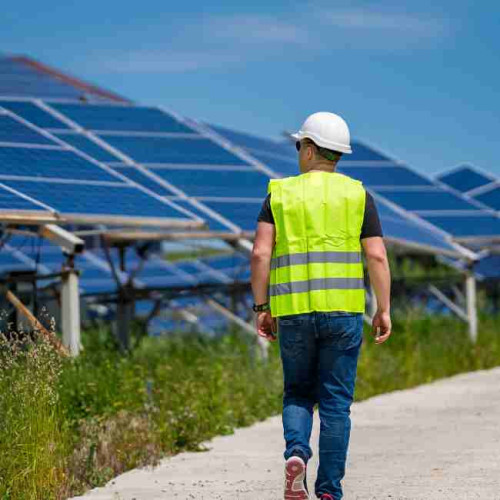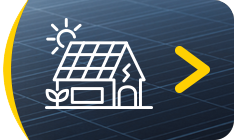- 16 Oct, 2017
- Solar Training , Self-consumption

Is solar energy the future? The photovoltaic industry is currently in a state of crisis. However, technology is constantly improving with new solar cells emerging and China entering the market for renewable energy. Such developments could reinvigorate the whole sector.
Will everything be powered by solar energy in the future? You might think this is unlikely as natural gas is more popular than ever and the solar industry has been in crisis since 2011. However, China is now trying to enter the market for renewable energy and new solar cells were developped. This could pave the way for a bright future for solar energy. Let's have a look at the underlying economic and technological factors at play.
The technologies available today
ParisTech Review. Today, photovoltaic solar energy is produced mainly from first generation silicon cells. But new generations are being developed. Can you quickly introduce us to the technologies involved and their challenges?
Didier Roux. Silicon cells remain the main technology used today, and she has not yet said her last word. Let us recall the principle of the photovoltaic cell. It is simple and has been known since the 19th century, even if it took Einstein to understand the physics of light.
Light is made up of photons, which could be defined as packets of elementary energy, with a mass. When they come into contact with matter, their mass is transformed into energy, in the form of heat for example. In some cases, and in particular that of semiconductors, of which silicon is a part, this energy can be used to extract electrons. This is called the photoelectric effect. First generation cells are electronic components that capture and channel these electrons to produce direct current.
Why is silicon used? Simply because it is abundant in a purified form (thanks to the electronics industry) and has the required properties. We can then distinguish different configurations: monocrystalline solar modules are more expensive but they have a good yield per m². Polycrystalline modules are slightly less efficient, but they are significantly cheaper. Finally, modules based on amorphous silicon, whose structure is not crystalline, should be mentioned. Their efficiency is lower. Amorphous silicon cells are an example of second generation cells: so-called thin film cells.
This thin film technology seems to be getting a lot of attention nowadays. What is it exactly?
You're right, the real issue today is thin films. Several industrial players, including First Solar in the United States and Saint-Gobain in France, have invested in this technology, which offers real advantages.
So, what is it about? Basically, the idea is to deposit very thin layers, in the order of a few microns, on a substrate (glass, metal, plastic). For industrial cells today, the materials used are mainly of two types: cadmium telluride (CdTe) or layers composed of four components (copper, indium, gallium and selenium).
You mentioned their advantages already: we know for example that with this method we can manufacture modules with a much larger surface area, and above all cut them easily.
The main advantage is that, due to the quantity of material used and the methods of deposition, in the industrial phase these technologies will be cheaper. They are not fully mature industrially, but, given the current installations, progress is rapid. CdTe technology is already less expensive than polycrystalline silicon technology.
Before having a look at the state of the market and the conditions for the development of this second generation, can you tell us a little bit about the third and fourth generations, which are still at the R&D stage?
You are right to point this out, we are talking about technologies that only exist in the lab for now. Under this common term of third generation, quite different technologies are grouped together. In some cases they use organic molecules and/or mineral nanoparticles. These systems are capable of absorbing light and transporting electrons. These are complex systems that have a certain intrinsic fragility to radiation. These technologies are interesting because they have the potential to be very cheap and can give yields of around 10% (for example in the case of Graetzel cells). But they still present an inconvenient, for the moment unresolved, which is the degradation of the organic part of the systems. This gives very significantly shorter life spans than the 20 to 30 years of conventional cells.
Multi-junction concentration cells are what I call the fourth generation: they are made up of a stack of layers that recover energy from the different portions of the sunlight spectrum. Their main disadvantage today is their very high price. However, there is no major obstacle to this fourth generation being profitable one day. It is simply a matter of improving costs on all links in the chain.
But I would like to point out one more thing: this technology will be less in competition with the technologies we have mentioned today than with thermal solar energy, sometimes with a concentration of CSP, for concentrated solar power.
Why is that?
Because these technologies require a lot of sunlight and tracking systems, which allow the modules to track the sun. We are in a very different configuration with thin layers, which remain efficient for indirect or diffuse radiation. Multi-junction cells, like concentrated solar energy, are only really effective with very intense radiation. They are well adapted to desert regions. The two technologies will therefore be competing.
Precisely, if a few years ago large concentrated solar projects appeared, this technology seems to be somewhat outdated today.
That's true, and it's not very difficult to understand: if today the CSP is not on the rise, it's simply that conventional photovoltaics has become more profitable. Siemens, for example, has withdrawn from the Desertec project. But I wouldn't talk about abandonment. Like the Font-Romeu solar furnace, these are pilot systems, on which much progress still needs to be made. Although solar energy has been known for several decades, in technological terms it does not have the degree of industrial maturity of photovoltaics. In world production, it should represent barely 1% of the installed photovoltaic capacities: there is still room for improvement.
We sometimes hear that the implementation of these systems in desert areas, far from the places of consumption, implies a significant investment in terms of distribution, and therefore an additional cost?
It is true, the idea of producing in desert areas and then supplying Western countries has the disadvantage of adding transport losses. However, countries near these deserted areas are increasingly in need of electricity and their populations are growing rapidly. Solar energy concentrates, or tomorrow multi-junction cells, can represent a relevant solution to power them. Researchers are working: long-distance transport problems are still subject to much work and solutions exist.
Future perspectives for solar energy
The intermittent nature of production is often presented as one of the major obstacles to the development of photovoltaics.
That's correct. A growth in solar electricity production will require a development of electricity storage capacities, this is one of the major challenges for energy in general. There are possible solutions "chemical storage, via hydrogen for example, mechanical storage" but for the moment, these solutions are not yet industrial. It should be noted that there is no lack of imagination or creativity on this subject. The question is rather to find the profitable process on the market. This problem must be addressed and there is no doubt that industrial solutions will develop.
There is also the problem of distribution, with the famous smart grids?
The two are linked. Smart networks, i.e. sophisticated and pilot networks, are necessary to accept forms of technologies that are less and less flexible and more dispersed on the network. It is an element of progress. But questions also arise: do we really need to make large networks everywhere? Wouldn't it make more sense to develop more independent systems and storage? In an Indian village that does not have electricity, if you have an efficient storage method, you can reasonably ask yourself the question: do I have an interest in connecting to the grid, or in producing my electricity, storing it and being autonomous? It is the same problem as the wireline telephone equipment compared to the mobile phone. There are countries that are overlooking the landline telephone. Tomorrow, we may see countries that have not yet invested in large networks prefer to develop small autonomous networks rather than large connected networks. Maybe that's what smart grids mean to them. Today, if we knew how to store at a reasonable cost, there are many places in the world where we would not be interested in networking..
Opponents of solar energy point out that it remains very expensive. When will it be profitable without subsidies?
I would like to start by rejecting the idea that the production of a photovoltaic module consumes more energy than it produces during its service life (about ten years). This was true in the 1960s, but today what is called the "energy return" is one to three years depending on the region and technology.
Let us now consider the competitiveness of solar energy in relation to other forms of electricity production. It is important to know that when we talk about electricity, we should not think in the same way about whether we are talking about a collector field built and operated by an industrial company or the roof of a private individual. For an industrial company, what matters is the cost of producing electricity compared to another technology. On the other hand, for a private individual, it is the price at which he buys his electricity that comes into play.
Let's start with individuals. We speak of network parity when the production cost is equal to the market price. This means that the relevance of solar energy is not the same in different countries. In France, for example, the preponderance of nuclear power now allows private individuals to benefit from a rather cheap electricity. But the recent drop in photovoltaic costs, to which we will return later, has helped to change the situation. The production cost for a private individual, by smoothing out the investments over 20 years, represents approximately 0.2 euros per kWh while the price of electricity in France is 0.1 euros per kWh. So we're not yet on the network parity. This is the case, on the other hand, in Italy, both because electricity is more expensive and because there is more sunshine. Germans who pay about €0.3 per kWh are also on the grid, such as some American regions, in California or Utah but not yet on the East coast.
The spectacular drop in the cost of panels has contributed to making solar energy more competitive, but the effects of this drop should not be overestimated. In France, the price of the panel represents only 20% of the investments for a roof, 50% for a production plant. It is therefore especially on the rest that savings are expected: the installation, the related equipment. The installation of photovoltaic panels on a roof in Germany costs about half of what it costs in France.
Let us now consider the issue from the point of view of electricity producers. Here, we basically compare production costs, even if environmental considerations or energy independence may be taken into account. And since it is a question of investing, it seems more accurate to compare solar electricity with that of future nuclear power plants, and not with those that are currently operating and were launched forty years ago. Take France, again: for a solar power plant in the south of the country, the production cost is 0.1 euros per KWh, compared to the 0.08 euros expected from third generation EPR-type nuclear power plants. The difference still exists, but it is no longer as significant as it was three years ago, when it ranged from 1 to 4.
Market dynamics
As you said, part of this cost reduction comes from the collapse in panel prices. The years 2011-2012 were very difficult for the photovoltaic industry, with the bankruptcy of many module producers in Europe and the United States. Where is the sector today?
The situation is a paradox. This is the crisis for module manufacturers: all are losing money, including Chinese producers. But electricity producers, on the other hand, buy very cheap modules. Many photovoltaic field projects are being launched today in California or Italy, in areas where there is a lot of sunlight, because it is profitable.
Today, Asia is responsible for about 70% of the world's panel production. And Chinese factories are operating at less than 50% of their capacity, because there are not enough buyers. There is clearly a problem of overcapacity at the global level.
In a situation like this, if you play the truth about prices, some of these companies should go bankrupt. But the Chinese authorities, who are aware of this, are doing two things. First, they do not ask for the repayment of investments. It is a form of subsidy. On the other hand, they have launched a major photovoltaic equipment plan which, in the long term, will make it possible to absorb part of the overcapacity.
How would you describe China's strategy: is it a trade war designed to ruin competition?
I don't think so. I think they let themselves be dragged into their investments without anticipating the risk of overcapacity. But it is the reaction of the authorities that seems interesting to me: if the Chinese decide not to close factories, we will therefore continue to produce a lot of solar panels in China, and this will probably result in the death of all the other producers, except for a few actors who will survive because they make high quality like Sun Power. It is likely that by 2020 Chinese manufacturers will be almost alone on the market. And so, as demand catches up with supply, panel production should return to profitability. If, on the other hand, there is a consolidation of players and massive capacity closures in China, module prices will rise and international players will become profitable again.
Some companies can hope to survive, because they have agreed to completely change their business model. This is the case of the American company First Solar, which specializes in thin-film cadmium telluride technology. It manufactured the cheapest modules, but with the fall in prices it was weakened. Its managers have therefore opted for a strategic shift: the company has started to produce electricity. It produces and installs its modules (including in China!), it produces and sells electricity.
But First Solar is an isolated case and the rapid decline in first generation prices has done a lot of damage to a sector that was not yet technologically mature. Innovation capacities have been destroyed, and industrial learning has not yet had time to take place. With a few exceptions, the sector is currently too late to catch up with the low selling price of Chinese manufacturers of industrial silicon panels through lower costs.
Potentially, thin film technology has the means to do so. But unless you change business models to get through the crisis, you have to accept losing money a few years before you can be profitable. That's the equation to solve. This can only be done with the support of investors, including states. We are not talking about a research effort here, but an industrial effort. The challenge is to build larger and larger factories, which cost more and more, to manufacture objects that you sell for a certain period of time at a loss. It's not easy to accept. But some investors are taking the risk, and not the least: Warren Buffet has just invested in photovoltaic power plants by SunPower in California.
Are Chinese panel manufacturers also interested in the second generation?
I think they're headed this way. All Chinese manufacturers are nowadays on silicon, but they have understood that the future generation is thin films. First Solar has launched this year a 30 MW project with a Chinese partner. China is investing. Its manufacturers will learn, and they will buy back the technologies owned by the competitors who are suffering.
What is the bottom line for European businesses?
I do not believe that French or German panel manufacturers can survive if nothing happens. But we are talking here about a complex game, where the winners are not necessarily obvious. Chinese manufacturers are now losing money. The people who buy the modules from them are European and American individuals and industrialists. This means that the Chinese state subsidizes electricity production in Europe and the United States.
There have been doubts about the strategy of subsidising feed-in tariffs in Europe. We can discuss the merits of state subsidies to help the emergence of an industrial sector in Europe, and it must be said that there is a risk to the German sector (the only one that has actually been set up). But that's only part of the story. Because German industrialists have developed a machine tool industry that is used to manufacture the panels, and their main customers are the Chinese. One of the main reasons why the Germans did not insist much on putting barriers at the entrance of Chinese photovoltaic panels is because they themselves sell panel making machines to the Chinese. In total, public subsidies have helped to develop and strengthen a strategic industrial sector.
Source: paristechreview.com











